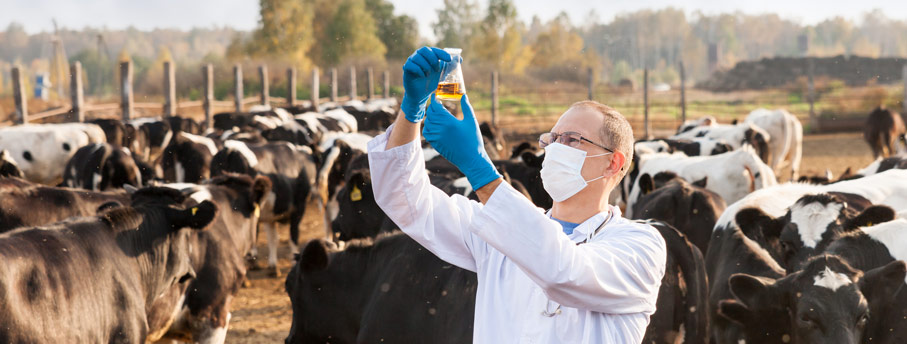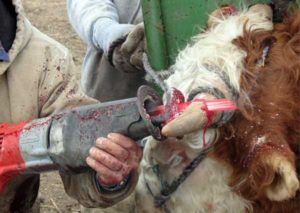Back to: AGRICULTURAL SCIENCE SS3
Welcome to class!
In today’s class, we will be talking about the principles of animal health management. Enjoy the class!
Principles of Animal Health Management

Livestock diseases
Diseases in animal mean any condition in which there is a deviation from the normal state of health or when there is any interference with the body processes which will make its body not to function in a normal way. This always gives rise to ill health, which does not allow the animal to perform less in areas of live weight gain, milk production, work done in case of work animals, egg or wool production etc.
Animal diseases are generally caused by viruses, bacteria, fungi, protozoa and malnutrition.








Classification of animal diseases
Based on organisms that cause diseases, the prevalent diseases of livestock can be grouped into
- Viral diseases
- Bacterial diseases
- Fungal diseases
- Protozoan diseases and
- Malnutrition or metabolic disorder.
Susceptibility to diseases
This refers to a condition in which the animal is easily attacked or infected by a disease.
Factors that could predispose animals to diseases
The factors which help in initiation and continuation of disease condition include:-
- Health status of the animal: Animals that are unhealthy can easily get infected more than those healthy animals.
- The farm environment: Dirty and unhygienic environment could easily predispose animals to diseases.
- Nutrition: Animals that are not fed properly in terms of quality and quantity can easily be infected by diseases.
- Management: Animals that are not properly managed in terms of administration of drugs and vaccines appropriately could easily get attacked by a disease.
- Unfavourable climatic conditions: Extreme of climatic conditions such as rainfall, temperature, wind etc could predispose animals to disease attack.
- Poor housing: If animals are not properly housed and are exposed to heavy rainfall and high temperature, they could easily be attacked by diseases and parasitic infestations can also break out.
- Stress conditions: Conditions or pressures caused by difficulties in life can predispose animals to disease attack.
- Breeds of animals: Poor breeds of animals can easily be prone to disease attack as against the good breeds.
Resistance to diseases
Disease resistance is the ability of the animal to withstand the attack by a pathogen and remain healthy.
Factors that determine the resistance of animal to disease
- Development of immunity
- Species of animal
- Inoculation
- Level of feeding
- Age of animal
- Physiological condition of the animal
Evaluation
- Define livestock diseases.
- Define immunity
Economic importance of animal diseases
- Poor growth is achieved
- Poor food utilization
- Low yield of productivity.
- Low income to expecting farmer
- Poor quality of animal products
- Death of livestock
Methods of preventing diseases
- Quarantine: New stock being brought to the farm should be separated from the animals originally on the farm for proper scrutiny.
- Vaccination: Farm animals should be vaccinated at the right time and doses to give them immunity against pathogenic organisms.
- Hygiene: Good hygiene must be taken to prevent infection of farm animals. This involves cleaning of pens, watering and feeding equipment, disposal of waste and regular disinfection.
- Good feeding: Animals should be properly fed to resist diseases attack.
- Breeding: Diseases resistant stocks should be bred on the farm.
- Rotational grazing: It makes building up of parasites to be avoided.
- Isolation: All sick animals should be isolated from healthy ones.
Evaluation
- Explain Quarantine
- Explain rotational grazing
General evaluation
- State the economic importance of farm animal diseases
- What is disease resistant?
- What is susceptibility to disease?
- List four classes of animal disease
- List three factors that determine resistant to diseases.
Reading assignment
Essential Agricultural Science for senior secondary schools by O.A. Iwena, Chapter 30, Page 383-386. Answer revision questions 11 and 14 on pages 396 and 397
Weekend assignment
- An effective way of ensuring built-in resistance to disease in calves is to a) vaccinate calves at weaning b) allow calves access to colostrums c) ensure regular veterinary check-up d) observe proper quarantine e) give a balanced diet
- Disease-causing organisms are referred to as a. vectors b. pathogens c. pests d. insect
- Animal diseases are generally caused by the following except a. protozoa b. nematode c. virus d. fungi
- An animal is said to be resistant to disease if the a. animal easily succumb to infection by the disease. b. presence of the disease pathogen does not cause expression of disease symptoms. c. animal is able to endure the effect of the disease. d. animal has no antibodies in its blood.
- The factors that can predispose animals to diseases include the following except
- poor housing b. immunity c. malnutrition d. unfavourable weather
Theory
- What is a livestock disease?
- Briefly explain four factors that could predispose animals to diseases.
- List ten common symptoms of animal disease.
In our next class, we will be talking about Symptoms, Effects, Transmission and Control of Selected Diseases. We hope you enjoyed the class.
Should you have any further question, feel free to ask in the comment section below and trust us to respond as soon as possible.
